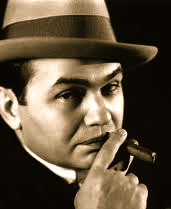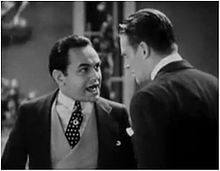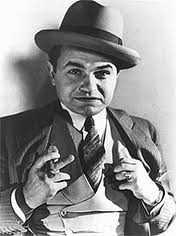Edward G. Robinson

The Stranger (1946) – Full Movie

In 1946, Mr. Wilson (Edward G. Robinson) of the United Nations War Crimes Commission is hunting for Nazi fugitive Franz Kindler (Orson Welles). Kindler has effectively concealed his Nazi activities prior to his escape to the United States. He assumes a new identity, Charles Rankin, lands a job as a university professor and marries Mary Longstreet (Loretta Young), who is the daughter of Supreme Court justice Judge Adam Longstreet.
Wilson releases Kindler’s former associate Meinike (Konstantin Shayne) and follows him to Harper, Connecticut, but Meinike is strangled before he can identify Kindler. Wilson must convince Mrs. Rankin, the only person who knows for certain that Meinike came to meet her husband, that her Charles is a war criminal.
The Stranger is a 1946 American film noir/drama film starring Orson Welles, Edward G. Robinson, and Loretta Young. Welles also directed the film, which was based on an Oscar-nominated screenplay written by Victor Trivas. Sam Spiegel was the film’s producer, and the film’s musical score is by Bronisław Kaper. It is believed that this is the first film released after World War II that showed footage of concentration camps. The Stranger was the only film made by Welles to have been a bona fide box office success on the first release (Citizen Kane had made back its budget and marketing, but not enough to make a profit). The copyright was by “The Haig Corporation” and it has been in the public domain for several years.
Mystery guest segment of the classic game show What’s My Line? with actor Edward G. Robinson (the fourth of five appearances that Robinson made on Whats My Line). Guest Steve Lawrence and regulars Bennett Cerf, Arlene Francis, and Dorothy Kilgallen appear on the panel. The program first aired on December 16, 1962.
Edward G. Robinson was best known for his appearances in numerous classic films, such as his iconic gangsters in Little Ceasar and the Humphrey Bogart movie, Key Largo, as well as Double Indemnity, Orson Welles’ The Stranger, and Larceny Inc. This was the fourth of five appearances that Edward G. Robinson made on What’s My Line.
1931 studio publicity photo
Edward G. Robinson (Yiddish: עמנואל גאָלדנבערג Emanuel Goldnberg; December 12, 1893 – January 26, 1973) was a Romanian-born American actor. A popular star during Hollywood’s Golden Age, he is best remembered for his roles as gangsters, such as Rico in his star-making film Little Caesar and as Rocco in Key Largo. Other memorable roles include Barton Keyes in the film noir Double Indemnity, and as Dathan in The Ten Commandments. Robinson was selected for an HonoraryAcademy Award for his work in the film industry, which was posthumously awarded two months after the actor’s death in 1973. He was included in the American Film Institute‘s list of the 25 greatest male stars in American cinema.
Career
He began his acting career in 1913 and made his Broadway debut in 1915. He made his film debut in a minor and uncredited role in 1916; in 1923 he made his named debut as E. G. Robinson in The Bright Shawl. One of many actors who saw his career flourish in the new sound film era rather than falter, he made only three films prior to 1930 but left his stage career that year and made 14 films between 1930-1932.
 Robinson in his breakout role, Little Caesar (1931)
Robinson in his breakout role, Little Caesar (1931)
 In Billy Wilder‘s Double Indemnity (1944)
In Billy Wilder‘s Double Indemnity (1944)
Robinson was popular in the 1930s and 1940s and was able to avoid many flops during a 50-year career that included 101 films. An acclaimed performance as the gangster Caesar Enrico “Rico” Bandello in Little Caesar (1931) led to him being typecast as a “tough guy” for much of his early career in works such as Five Star Final (1931), Smart Money (1931; his only movie with James Cagney), Tiger Shark (1932), Kid Galahad(1937) with Bette Davis and Humphrey Bogart, and A Slight Case of Murder. Due to age, he could not qualify for military service during WWII. Instead in the 1940s, Robinson demonstrated his ability to succeed in comedic and film noir roles, including Raoul Walsh‘s Manpower (1941) with Marlene Dietrich and George Raft, Larceny, Inc. (1942) with Jane Wyman and Broderick Crawford, Billy Wilder‘s Double Indemnity (1944) with Fred MacMurray and Barbara Stanwyck, Fritz Lang‘s The Woman in the Window (1945) with Joan Bennett and Raymond Massey, Fritz Lang‘s Scarlet Street (1945) with Joan Bennett and Dan Duryea, and Orson Welles‘ The Stranger (1946) with Orson Welles and Loretta Young. As a memorable tribute to his past gangster roles, he appeared for director John Huston as ‘Johnny Rocco’ in Key Largo (1948). Key Largo would be the last of five films he made with Humphrey Bogart and the only one in which Bogart didn’t play a supporting role. Bogart had top billing but Robinson’s name was placed slightly higher and to the right of Bogart’s on posters and in the film itself, and his image was larger and centered in the original posters, with Bogart in the background while Robinson wrestles with Lauren Bacall in the foreground. In the film’s trailer, Bogart is mentioned more often but at the trailer’s very end, Robinson’s name is listed above Bogart’s in a cast list of the main players. The role of Rocco was quite similar to that of Duke Mantee, Bogart’s breakthrough role in 1936 that the studio had initially assigned to Robinson.
 Robinson was an outspoken critic of fascism and nazism, and donated more than US$ 250,000 to 850 political and charitable groups between 1939 and 1949. He was host to the Committee of 56 who gathered at his home on 9 December 1938, signing a “Declaration of Democratic Independence” which called for a boycott of all German Products. He played FBI agent Turrou in Confessions of a Nazi Spy, the first American film which showed nazism as a threat to the United States in 1939, and Paul Ehrlichin Dr. Ehrlich’s Magic Bullet and Paul Julius Reuter in A Dispatch from Reuter’s, both Jewish Biography films of 1940. In 1942, he volunteered for military service and was sent to London.
Robinson was an outspoken critic of fascism and nazism, and donated more than US$ 250,000 to 850 political and charitable groups between 1939 and 1949. He was host to the Committee of 56 who gathered at his home on 9 December 1938, signing a “Declaration of Democratic Independence” which called for a boycott of all German Products. He played FBI agent Turrou in Confessions of a Nazi Spy, the first American film which showed nazism as a threat to the United States in 1939, and Paul Ehrlichin Dr. Ehrlich’s Magic Bullet and Paul Julius Reuter in A Dispatch from Reuter’s, both Jewish Biography films of 1940. In 1942, he volunteered for military service and was sent to London.
On three occasions in 1950 and 1952, he was called to testify in front of the House Un-American Activities Committee (HUAC) and was threatened with blacklisting. Robinson took steps to clear his name, such as having a representative go through his check stubs to ensure that none had been issued to subversive organizations. He did not give names of Communist sympathizers, but he repudiated the organizations he had belonged to in the 1930s and 1940s and his own name was cleared, but he only received smaller roles and even those less frequently. He humiliated himself by publishing an article with the title “How the Reds made a Sucker Out of Me” in October 1952, but was called to testify again before the House Un-American Activities Committee in January 1954.
During this time, he appeared in numerous ‘B’ movies for American International Pictures and other low-budget studios while attempting to regain his prior status as a major film actor. Some of these films, such as Vice Squad (1953) proved excellent in their own right, while others, such as 1958’s Tank Battalion, were critical and commercial failures. Anti-communist director Cecil B. DeMille cast him as Dathan in The Ten Commandments in 1956, freeing him to make A-list films again. Robinson’s acting career was subsequently bolstered by notable roles in 1959’s A Hole in the Head opposite Frank Sinatra and The Cincinnati Kid (1965), which showcased Robinson alongside Steve McQueen.
Robinson tried to talk his way into the titular part in The Godfather (1972), which was how he had won the role of Little Caesar 40 years earlier, but Francis Ford Coppola decided on Marlon Brando instead, over the initial objections of the studio. Director Peter Bogdanovich was offered the film before Coppola but turned it down, and has insisted ever since that he would have definitely cast Robinson in the part.
Robinson’s last-filmed scene of his last acting role was a euthanasia sequence in the science fiction cult film Soylent Green(1973). Immediately prior to filming the scene, Robinson told his co-star, and long-time friend Charlton Heston, that he was dying from cancer and had weeks to live, at best. As the actors were to play the scene together, Robinson thought that the knowledge of his impending death would affect Heston’s playing of the scene, thus the on-screen tears of Heston’s character in the final print of the film are genuine. Robinson died twelve days later.
Personal life
Robinson married his first wife, stage actress Gladys Lloyd, in 1927; born Gladys Lloyd Cassell, she was the former wife of Ralph L. Vestervelt and the daughter of Clement C. Cassell, an architect, sculptor, and artist. The couple had one son, Edward Goldenberg Robinson, Jr. (a.k.a. Manny Robinson, 1933–1974), as well as a daughter from Gladys Robinson’s first marriage. In 1956 he was divorced from his wife, in 1958 he married 38 year old Jane Bodenheimer, a dress designer known as Jane Arden.
Robinson spoke seven languages. He built up a significant art collection. In 1956, he sold it to Greek shipping tycoon Stavros Niarchos to raise cash for his divorce settlement with Gladys Robinson; his finances had suffered due to underemployment in the early 1950s. One of his chief pastime was collecting records of the world’s leading concerts. An inveterate cigar smoker, Robinson smoked cigars in many of his movie roles to accentuate his character.
A liberal Democrat, he attended the 1960 Democratic Convention in Los Angeles, California.
Robinson died from cancer in 1973, and is buried in a crypt in the family mausoleum at Beth-El Cemetery in the Ridgewood area of the borough of Queens in New York City.
Legacy
 Robinson has been the inspiration for a number of television characters. Firstly, an early version of the gangster character Rocky, featured in the Bugs Bunny cartoon Racketeer Rabbit, shared his likeness. This version of the character also appears briefly in Justice League, in the episode “Comfort and Joy”, as an alien with Robinson’s face and non-human body, who hovers past the screen as a background character. Similar caricatures also appeared in The CooCooNut Grove, Thugs with Dirty Mugs and Hush My Mouse. Another character based on Robinson’s gangster image was The Frog from the cartoon series Courageous Cat and Minute Mouse. The voice of B.B. Eyes in The Dick Tracy Show was based on Robinson, with Mel Blanc and Jerry Hausnersharing voicing duties. Voice actor Hank Azaria has said that the voice of Simpsons character police chief Clancy Wiggum is an impression of Robinson. This has been explicitly joked about in episodes of the show. In “The Day the Violence Died” (1996), a character states that Chief Wiggum is clearly based on Robinson. In 2008’s “Treehouse of Horror XIX“, Wiggum and Robinson’s ghost each accuse the other of being rip-offs.
Robinson has been the inspiration for a number of television characters. Firstly, an early version of the gangster character Rocky, featured in the Bugs Bunny cartoon Racketeer Rabbit, shared his likeness. This version of the character also appears briefly in Justice League, in the episode “Comfort and Joy”, as an alien with Robinson’s face and non-human body, who hovers past the screen as a background character. Similar caricatures also appeared in The CooCooNut Grove, Thugs with Dirty Mugs and Hush My Mouse. Another character based on Robinson’s gangster image was The Frog from the cartoon series Courageous Cat and Minute Mouse. The voice of B.B. Eyes in The Dick Tracy Show was based on Robinson, with Mel Blanc and Jerry Hausnersharing voicing duties. Voice actor Hank Azaria has said that the voice of Simpsons character police chief Clancy Wiggum is an impression of Robinson. This has been explicitly joked about in episodes of the show. In “The Day the Violence Died” (1996), a character states that Chief Wiggum is clearly based on Robinson. In 2008’s “Treehouse of Horror XIX“, Wiggum and Robinson’s ghost each accuse the other of being rip-offs.
Robinson was never nominated for an Academy Award, but in 1973 he was awarded an honorary Oscar in recognition that he had “achieved greatness as a player, a patron of the arts, and a dedicated citizen … in sum, a Renaissance man.” He had been notified of the honor, but died two months before the award ceremony, thus the award was collected by his widow Jane Robinson.


